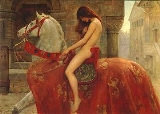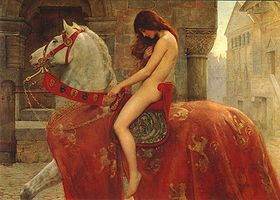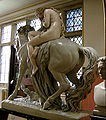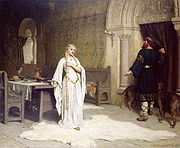
Lady Godiva
Encyclopedia


Floruit
Floruit , abbreviated fl. , is a Latin verb meaning "flourished", denoting the period of time during which something was active...
1040–1070), was an Anglo-Saxon
Anglo-Saxons
Anglo-Saxon is a term used by historians to designate the Germanic tribes who invaded and settled the south and east of Great Britain beginning in the early 5th century AD, and the period from their creation of the English nation to the Norman conquest. The Anglo-Saxon Era denotes the period of...
noblewoman who, according to legend
Legend
A legend is a narrative of human actions that are perceived both by teller and listeners to take place within human history and to possess certain qualities that give the tale verisimilitude...
, rode naked through the streets of Coventry
Coventry
Coventry is a city and metropolitan borough in the county of West Midlands in England. Coventry is the 9th largest city in England and the 11th largest in the United Kingdom. It is also the second largest city in the English Midlands, after Birmingham, with a population of 300,848, although...
in order to gain a remission of the oppressive taxation imposed by her husband on his tenants. The name "Peeping Tom
Peeping Tom
Peeping Tom is a nickname commonly given to voyeurs, particularly males. It originated with the legend of Lady Godiva, when a man named Tom watched her during her nude ride and was struck blind or dead.It may also refer to:In music...
" for a voyeur originates from later versions of this legend in which a man named Tom had watched her ride and was struck blind or dead.
Historical figure
Lady Godiva was the wife of LeofricLeofric, Earl of Mercia
Leofric was the Earl of Mercia and founded monasteries at Coventry and Much Wenlock. Leofric is remembered as the husband of Lady Godiva.-Life and political influence:...
, Earl of Mercia
Mercia
Mercia was one of the kingdoms of the Anglo-Saxon Heptarchy. It was centred on the valley of the River Trent and its tributaries in the region now known as the English Midlands...
. They had one proved son Aelfgar, Earl of Mercia.
Lady Godiva's name occurs in charters and the Domesday survey
Domesday Book
Domesday Book , now held at The National Archives, Kew, Richmond upon Thames in South West London, is the record of the great survey of much of England and parts of Wales completed in 1086...
, though the spelling varies. The Old English name Godgifu or Godgyfu meant "gift of God"; Godiva was the Latinised version. Since the name was a popular one, there are contemporaries of the same name.
If she was the same Godiva who appears in the history of Ely Abbey, the Liber Eliensis
Liber Eliensis
The Liber Eliensis is a 12th-century English chronicle and history, written in Latin. Composed in three books, it was written at Ely Abbey on the island of Ely in the fenlands of eastern Cambridgeshire. Ely Abbey became the cathedral of a newly formed bishopric in 1109...
, written at the end of 12th century, then she was a widow when Leofric married her. Both Leofric and Godiva were generous benefactors to religious houses. In 1043 Leofric founded and endowed a Benedictine monastery
Order of Saint Benedict
The Order of Saint Benedict is a Roman Catholic religious order of independent monastic communities that observe the Rule of St. Benedict. Within the order, each individual community maintains its own autonomy, while the organization as a whole exists to represent their mutual interests...
at Coventry. on the site of a nunnery destroyed by the Danes in 1016. Writing in the 12th century, Roger of Wendover
Roger of Wendover
Roger of Wendover , probably a native of Wendover in Buckinghamshire, was an English chronicler of the 13th century.At an uncertain date he became a monk at St Albans Abbey; afterwards he was appointed prior of the cell of Belvoir, but he forfeited this dignity in the early years of Henry III,...
credits Godiva as the persuasive force behind this act. In the 1050s, her name is coupled with that of her husband on a grant of land to the monastery of St Mary, Worcester and the endowment of the minster at Stow St Mary, Lincolnshire
Lincolnshire
Lincolnshire is a county in the east of England. It borders Norfolk to the south east, Cambridgeshire to the south, Rutland to the south west, Leicestershire and Nottinghamshire to the west, South Yorkshire to the north west, and the East Riding of Yorkshire to the north. It also borders...
. She and her husband are commemorated as benefactors of other monasteries at Leominster
Leominster
Leominster is a market town in Herefordshire, England, located approximately north of the city of Hereford and south of Ludlow, at...
, Chester, Much Wenlock
Much Wenlock
Much Wenlock, earlier known as Wenlock, is a small town in central Shropshire, England. It is situated on the A458 road between Shrewsbury and Bridgnorth. Nearby, to the northeast, is the Ironbridge Gorge, and the new town of Telford...
and Evesham
Evesham Abbey
Evesham Abbey was founded by Saint Egwin at Evesham in England between 700 and 710 A.D. following a vision of the Virgin Mary by Eof.According to the monastic history, Evesham came through the Norman Conquest unusually well, because of a quick approach by Abbot Æthelwig to William the Conqueror...
. She gave Coventry a number of works in precious metal made for the purpose by the famous goldsmith Mannig, and bequeathed a necklace valued at 100 marks
Mark (money)
Mark was a measure of weight mainly for gold and silver, commonly used throughout western Europe and often equivalent to 8 ounces. Considerable variations, however, occurred throughout the Middle Ages Mark (from a merging of three Teutonic/Germanic languages words, Latinized in 9th century...
of silver. Another necklace went to Evesham, to be hung around the figure of the Virgin accompanying the life-size gold and silver rood
Rood
A rood is a cross or crucifix, especially a large one in a church; a large sculpture or sometimes painting of the crucifixion of Jesus.Rood is an archaic word for pole, from Old English rōd "pole", specifically "cross", from Proto-Germanic *rodo, cognate to Old Saxon rōda, Old High German ruoda...
she and her husband gave, and St Paul's Cathedral, London received a gold-fringed chasuble
Chasuble
The chasuble is the outermost liturgical vestment worn by clergy for the celebration of the Eucharist in Western-tradition Christian Churches that use full vestments, primarily in the Roman Catholic, Anglican and Lutheran churches, as well as in some parts of the United Methodist Church...
. She and her husband were among the most munificent of the several large Anglo-Saxon donors of the last decades before the Conquest; the early Norman bishops made short work of their gifts, carrying them off to Normandy or melting them down for bullion.
The manor of Woolhope
Woolhope
- Location :Woolhope is located about 7 miles east of Hereford.- History :The manor of Woolhope in Herefordshire, along with three others, was given to the cathedral at Hereford before the Norman Conquest by the benefactresses Wulviva and Godiva, local Anglo-Saxon landowners before the Norman...
in Herefordshire
Herefordshire
Herefordshire is a historic and ceremonial county in the West Midlands region of England. For Eurostat purposes it is a NUTS 3 region and is one of three counties that comprise the "Herefordshire, Worcestershire and Gloucestershire" NUTS 2 region. It also forms a unitary district known as the...
, along with four others, was given to the cathedral at Hereford
Hereford
Hereford is a cathedral city, civil parish and county town of Herefordshire, England. It lies on the River Wye, approximately east of the border with Wales, southwest of Worcester, and northwest of Gloucester...
before the Norman Conquest by the benefactresses Wulviva
Wulviva
Wulviva was an Anglo-Saxon noblewoman. Her name survives in that of the Herefordshire village of Woolhope, meaning "Wulviva's Hope" ....
and Godiva – usually held to be this Godiva and her sister. The church there has a 20th century stained glass
Stained glass
The term stained glass can refer to coloured glass as a material or to works produced from it. Throughout its thousand-year history, the term has been applied almost exclusively to the windows of churches and other significant buildings...
window representing them.
Her mark, di Ego Godiva Comitissa diu istud desideravi, appears on a charter purportedly given by Thorold of Bucknall to the Benedictine monastery of Spalding
Spalding Priory
Spalding Priory was a small Benedictine house in the town of Spalding, Lincolnshire. It was founded as a cell of Croyland Abbey, in 1052, by Leofric, Earl of Mercia and his wife, Godiva, Countess of Leicester. It was supported by Leofric's eldest son...
. However, this charter is considered spurious by many historians. Even so it is possible that Thorold, who appears in the Domesday Book
Domesday Book
Domesday Book , now held at The National Archives, Kew, Richmond upon Thames in South West London, is the record of the great survey of much of England and parts of Wales completed in 1086...
as sheriff of Lincolnshire, was her brother.
After Leofric's death in 1057, his widow lived on until sometime between the Norman Conquest of 1066 and 1086. She is mentioned in the Domesday survey as one of the few Anglo-Saxons and the only woman to remain a major landholder shortly after the conquest. By the time of this great survey in 1086, Godiva had died, but her former lands are listed, although now held by others. Thus, Godiva apparently died between 1066 and 1086.
The place where Godiva was buried has been a matter of debate. According to the Chronicon Abbatiae de Evesham
Chronicon Abbatiae de Evesham
The Chronicon Abbatiae de Evesham or Chronicle of the Abbey of Evesham, sometimes the Evesham Chronicle, is a medieval chronicle written at and about Evesham Abbey in England.-Contents and authorship:...
, or Evesham Chronicle, she was buried at the Church of the Blessed Trinity at Evesham, which is no longer standing. According to the account in the Oxford Dictionary of National Biography, "There is no reason to doubt that she was buried with her husband at Coventry, despite the assertion of the Evesham chronicle that she lay in Holy Trinity, Evesham."
Dugdale
William Dugdale
Sir William Dugdale was an English antiquary and herald. As a scholar he was influential in the development of medieval history as an academic subject.-Life:...
(1656) says that a window with representations of Leofric and Godiva was placed in Trinity Church, Coventry
Holy Trinity Church, Coventry
Holy Trinity Church, Coventry is a parish church in the Church of England located in Coventry City Centre, West Midlands, England.Above the chancel arch is probably the most impressive Doom wall-painting now remaining in an English church.-History:...
, about the time of Richard II
Richard II of England
Richard II was King of England, a member of the House of Plantagenet and the last of its main-line kings. He ruled from 1377 until he was deposed in 1399. Richard was a son of Edward, the Black Prince, and was born during the reign of his grandfather, Edward III...
.
Legend
According to the popular story, Lady Godiva took pity on the people of Coventry, who were suffering grievously under her husband's oppressive taxation. Lady Godiva appealed again and again to her husband, who obstinately refused to remit the tolls. At last, weary of her entreaties, he said he would grant her request if she would strip naked and ride through the streets of the town. Lady Godiva took him at his word and, after issuing a proclamation that all persons should stay indoors and shut their windows, she rode through the town, clothed only in her long hair. Just one person in the town, a tailor ever afterwards known as Peeping TomPeeping Tom
Peeping Tom is a nickname commonly given to voyeurs, particularly males. It originated with the legend of Lady Godiva, when a man named Tom watched her during her nude ride and was struck blind or dead.It may also refer to:In music...
, disobeyed her proclamation in one of the most famous instances of voyeurism
Voyeurism
In clinical psychology, voyeurism is the sexual interest in or practice of spying on people engaged in intimate behaviors, such as undressing, sexual activity, or other activity usually considered to be of a private nature....
. In the story, Tom bores a hole in his shutters so that he might see Godiva pass, and is struck blind. In the end, Godiva's husband keeps his word and abolishes the onerous taxes.
Some historians have discerned elements of Pagan fertility rituals in the Godiva story whereby a young "May Queen
May Queen
The May Queen or Queen of May is a term which has two distinct but related meanings, as a mythical figure and as a holiday personification.-Festivals:...
" was led to the sacred Cofa's tree perhaps to celebrate the renewal of spring The oldest form of the legend has Godiva passing through Coventry market from one end to the other while the people were assembled, attended only by two knights. This version is given in Flores Historiarum
Flores Historiarum
The Flores Historiarum is a Latin chronicle dealing with English history from the creation to 1326 . It was compiled by various persons and quickly acquired contemporary popularity, for it was continued by many hands in many manuscript traditions...
by Roger of Wendover
Roger of Wendover
Roger of Wendover , probably a native of Wendover in Buckinghamshire, was an English chronicler of the 13th century.At an uncertain date he became a monk at St Albans Abbey; afterwards he was appointed prior of the cell of Belvoir, but he forfeited this dignity in the early years of Henry III,...
(died 1236), a somewhat gullible collector of anecdotes, who quoted from an earlier writer.

Chemise
The term chemise or shift can refer to the classic smock, or else can refer to certain modern types of women's undergarments and dresses...
, a sleeveless white garment similar to a slip
Slip (clothing)
Slip is a woman's undergarment worn beneath a dress or skirt to help it hang smoothly and to prevent chafing of the skin from coarse fabrics such as wool...
today and one which was certainly considered "underwear". Thus, some scholars speculate, Godiva might have actually travelled through town as a penitent, in her shift. Godiva's story could have passed into folk history to be recorded in a romanticised version. Another theory has it that Lady Godiva's "nakedness" might refer to her riding through the streets stripped of her jewellery, the trademark of her upper class
Upper class
In social science, the "upper class" is the group of people at the top of a social hierarchy. Members of an upper class may have great power over the allocation of resources and governmental policy in their area.- Historical meaning :...
rank. However, both of these attempts to reconcile known facts with legend are weak; in the era of the earliest accounts, the word "naked" is only known to mean "without any clothing whatsoever".
The story was modified by printer Richard Grafton
Richard Grafton
Richard Grafton , was King's Printer under Henry VIII and Edward VI. He was a member of the Grocers' Company and MP for Coventry elected 1562-63.-Under Henry VIII:...
, MP for Coventry, elected 1562-63. Grafton was an ardent Protestant and sanitized the earlier story. In his version Godiva summoned the officials of Coventry and ordered them to shutter all windows and keep the general population within "upon a great pain".
The later story, with its episode of "Peeping Tom", appeared first among 17th century chroniclers.
The story is not found in the admittedly few sources contemporary with Godiva. Coventry was still a small settlement, with only 69 families (and the monastery) recorded in the Domesday Book some decades later. Lastly, the only recorded tolls were on horses. Thus, it remains doubtful whether there is any historical basis for the famous ride. The story is particularly doubtful since Countess Godiva would herself have been responsible for setting taxation in Coventry, Salic law
Salic law
Salic law was a body of traditional law codified for governing the Salian Franks in the early Middle Ages during the reign of King Clovis I in the 6th century...
not applying to Saxon society. If only because of the nudity in the story, its popularity has been maintained, and spread internationally, many references in modern popular culture
Lady Godiva in popular culture
Lady Godiva was an Anglo-Saxon noblewoman who, according to legend, rode naked through the streets of Coventry, in England, in order to gain a remission of the oppressive taxation imposed by her husband on his tenants...
.
Images in art and society
The Herbert Art Gallery & Museum, in Coventry, maintains a permanent exhibition on the subject. The oldest painting, was commissioned by the County of the City of CoventryCounty of the City of Coventry
The County of the City of Coventry was a former English county, which existed between 1451 and 1842.The county covered an area of around and contained the city of Coventry and the surrounding villages of Ansty, Asthull, Biggin, Binley, Caludon, Exhall, Foleshill, Harnell, Horwell, Radford, Stoke,...
in 1586 and produced by a refugee Flemish artist. His painting depicts a "voluptuously displayed" Lady Godiva against the background of a "fantastical Italianate Coventry". In addition the Gallery has collected many Victorian interpretations of the subject described by Marina Warner as "an oddly composed Landseer
Landseer
Landseer may refer to:* Sir Edwin Henry Landseer , painter* Landseer , Thoroughbred racehorse trained in Ireland* Landseer , a black-and-white variant of the Newfoundland, named after the painter...
, a swooning Watts
George Frederic Watts
George Frederic Watts, OM was a popular English Victorian painter and sculptor associated with the Symbolist movement. Watts became famous in his lifetime for his allegorical works, such as Hope and Love and Life...
and a sumptuous Alfred Woolmer
Alfred Woolmer
Alfred Joseph Woolmer was a painter whose subject matter covered the literary and historical genre. He was exceptionally prolific and, by age sixty, the number of works he had exhibited had reached 355 at the Society of British Artists, 45 at the British Institution, and 12 at the Royal...
". Colliers' Lady Godiva (above) was bequeathed by social reformer, Thomas Hancock Nunn. When he died in 1937 it was offered to the Corporation of Hampstead. Should the request be refused, presumably on grounds of propriety, the painting was to be offered to Coventry. This happened and it now hangs in the Herbert.
External links
- Cecilia Parsons, "Countess Godiva", 1999, revised 2004: biography and developing legend
- BBC News – the unearthing of a stained glass window identified with Lady Godiva
- James Grout: Lady Godiva, part of the Encyclopædia Romana
- How Lady Godiva Got a Tax Break

